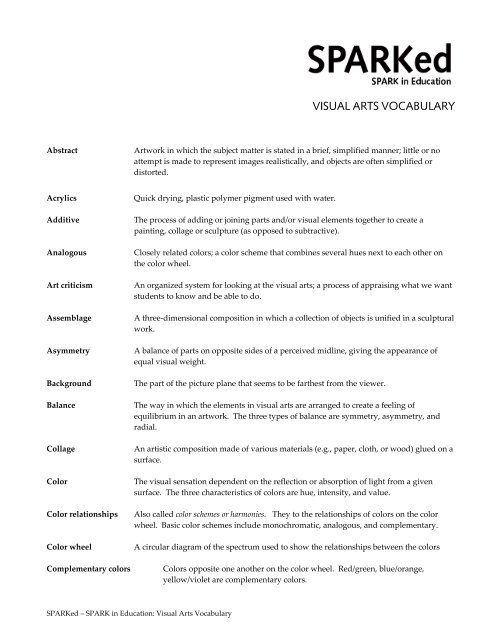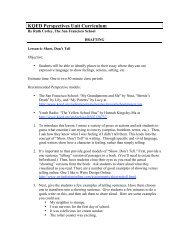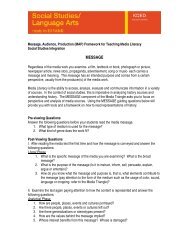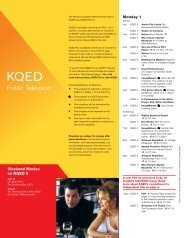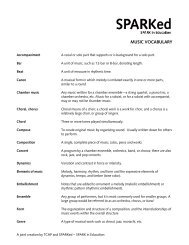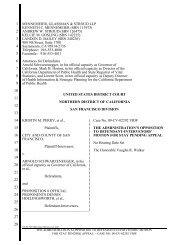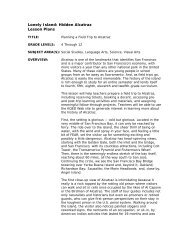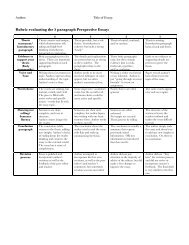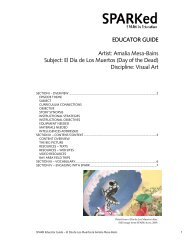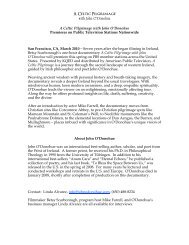VISUAL ARTS VOCABULARY - KQED
VISUAL ARTS VOCABULARY - KQED
VISUAL ARTS VOCABULARY - KQED
You also want an ePaper? Increase the reach of your titles
YUMPU automatically turns print PDFs into web optimized ePapers that Google loves.
<strong>VISUAL</strong> <strong>ARTS</strong> <strong>VOCABULARY</strong><br />
Abstract Artwork in which the subject matter is stated in a brief, simplified manner; little or no<br />
attempt is made to represent images realistically, and objects are often simplified or<br />
distorted.<br />
Acrylics Quick drying, plastic polymer pigment used with water.<br />
Additive The process of adding or joining parts and/or visual elements together to create a<br />
painting, collage or sculpture (as opposed to subtractive).<br />
Analogous Closely related colors; a color scheme that combines several hues next to each other on<br />
the color wheel.<br />
Art criticism An organized system for looking at the visual arts; a process of appraising what we want<br />
students to know and be able to do.<br />
Assemblage A three-dimensional composition in which a collection of objects is unified in a sculptural<br />
work.<br />
Asymmetry A balance of parts on opposite sides of a perceived midline, giving the appearance of<br />
equal visual weight.<br />
Background The part of the picture plane that seems to be farthest from the viewer.<br />
Balance The way in which the elements in visual arts are arranged to create a feeling of<br />
equilibrium in an artwork. The three types of balance are symmetry, asymmetry, and<br />
radial.<br />
Collage An artistic composition made of various materials (e.g., paper, cloth, or wood) glued on a<br />
surface.<br />
Color The visual sensation dependent on the reflection or absorption of light from a given<br />
surface. The three characteristics of colors are hue, intensity, and value.<br />
Color relationships Also called color schemes or harmonies. They to the relationships of colors on the color<br />
wheel. Basic color schemes include monochromatic, analogous, and complementary.<br />
Color wheel A circular diagram of the spectrum used to show the relationships between the colors<br />
Complementary colors Colors opposite one another on the color wheel. Red/green, blue/orange,<br />
yellow/violet are complementary colors.<br />
SPARKed – SPARK in Education: Visual Arts Vocabulary
Composition The overall placement and organization of elements in a work of art, as well as the<br />
interrelationships between individual elements.<br />
Content The representations, messages, ideas, and/or feelings expressed in a work of art.<br />
Contour line drawings Drawing that represents the edges and ridges of a form, without tonal variation,<br />
shading, etc.<br />
Contrast Differences between two or more elements (e.g., value, color, texture) in a composition;<br />
juxtaposition of dissimilar elements in a work of art. Also refers the degree of difference<br />
between the lightest and darkest areas of an image.<br />
Cool colors Colors suggesting coolness, blues, greens, violets and their variants.<br />
Design The plan, conception, or organization of a work of art; the arrangement of independent<br />
parts (the elements of art) to form a coordinated whole.<br />
Distortion The condition of being twisted or altered from a usual or regular shape. In visual art,<br />
distortion is often used as an expressive technique.<br />
Dominance An emphasis of one aspect, characteristic or quality in an image in relation to all others.<br />
Elements of art Sensory components used to create and talks about works of art; line, color, shape/form,<br />
texture, value, space.<br />
Emphasis Special attention or embellishment on an element, characteristic, or object in a work of art<br />
that makes it stand out from others.<br />
Expressive content Content expressive of ideas and moods in a work of art.<br />
Foreground Part of a two-dimensional artwork that appears to be nearer the viewer or in the “front”<br />
of the image. Middle ground and background are the parts of the picture that appear to be<br />
farther and farthest away.<br />
Focal point The place in a work of art at which attention becomes focused because of an element<br />
emphasized in some way.<br />
Form (1) The particular characteristics of an artwork’s visual elements (as distinguished from<br />
its subject matter or content). (2) A three-dimensional volume or the illusion of three<br />
dimensions; related to shape (which is 2-D).<br />
Function Purpose and use of a work of art.<br />
Genre The representation of people, subjects, and scenes from everyday life.<br />
Gesture drawing The drawing of lines quickly and loosely to show movement in a subject.<br />
Harmony The principle of design that creates unity within a work of art.<br />
SPARKed – SPARK in Education: Visual Arts Vocabulary
Hue The gradation or attribute of a color that defines it’s general classification as a red, blue,<br />
yellow, green, or intermediate color.<br />
Installation art The combining of elements into a singular artwork that is specifically located in one<br />
place; an artwork that exists only in the place in which it was/is installed, and is not able<br />
to be relocated like a painting or print.<br />
Intensity Also called chroma or saturation; refers to the brightness of a color (a color is full in<br />
intensity only when in its pure form and unmixed). Color intensity can be changed by<br />
adding black, white, gray, or an opposite color on the color wheel.<br />
Line In visual art, a delineation or fracturing of space in color or black and white. Line<br />
qualities can vary in width, length, gesture, color, direction, etc.<br />
Linear perspective A graphic system used to create the illusion of depth and volume on a flat surface. In<br />
images of buildings and objects, the lines defining their edges and features are slanted,<br />
making them appear to extend back into space.<br />
Mass The outside size and bulk of an object, such as a building or a sculpture; the visual weight<br />
of an object.<br />
Maquette A preliminary model (as of a sculpture or a building), usually small.<br />
Media (1) Plural of medium referring to materials used to make works of art. (2) Classifications of<br />
artworks, such as painting, printmaking, sculpture, film, etc.).<br />
Middle ground Area of a two-dimensional work of art between the foreground (closest to the front) and<br />
background (furthest receded).<br />
Mixed media An artwork in which more than one type of art material.<br />
Monochromatic Use of only one hue or color, that can vary in value or intensity.<br />
Mood The state of mind or emotion communicated in a work of art, through color, composition,<br />
media, scale, size, etc.<br />
Motif A repeated pattern, often creating a sense of rhythm.<br />
Movement The principle of design that deals with the creation of action.<br />
Multimedia Computer programs that involve users in the design and organization of text, graphics,<br />
video, and sound in one presentation.<br />
Negative space Shapes or spaces that are or represent the areas unoccupied by objects.<br />
Neutral colors Black, white, gray, and variations of brown. They are included in the color family called<br />
earth colors.<br />
Nonobjective Having no recognizable object or subject; also, nonrepresentational.<br />
SPARKed – SPARK in Education: Visual Arts Vocabulary
Oils Oil-based pigment used with paint thinner, turpentine, or other non-water-based<br />
suspension.<br />
One-point perspective A way to show 3-D objects on a 2-D surface, lines appear to go away from the<br />
viewer meet at a single point on the horizon known as the vanishing point.<br />
Organic Refers to shapes or forms not of geometric shape, having irregular edges, surfaces, or<br />
objects similar to natural forms.<br />
Pattern A design, image, or shape repeated in a predictable combination.<br />
Performance art A type of art in which an event or events are planned and enacted before an audience for<br />
aesthetic reasons.<br />
Perspective A system for representing three-dimensional objects viewed in spatial recession on a<br />
two-dimensional surface.<br />
Point of view The angle from which a viewer sees the objects or scene in an image.<br />
Portfolio A systematic, organized collection of artwork, usually student artwork.<br />
Positive Shapes or spaces in an image that represent solid objects or forms.<br />
Printmaking The transference of an image from one surface (plate or block) to another (usually paper)<br />
using ink.<br />
Primary colors Red, yellow, and blue. From these all other colors are created.<br />
Principles of design A design concept describing the ways in which the elements of an image are arranged<br />
(i.e. balance, contrast, dominance, emphasis, movement, repetition, rhythm, variation,<br />
unity).<br />
Properties of color The characteristics of color that are perceived: hue, value, and intensity.<br />
Proportion The scale relationships of one part to the whole and of one part to another. In images of<br />
figures, the appropriate balance between the size of body and its limbs.<br />
Reflection Personal and thoughtful consideration of an artwork, an aesthetic experience, or the<br />
creative process.<br />
Rhythm Repetitive visual elements that achieve a specific effect.<br />
Rubric A guide for judgment or scoring, a description of expectations.<br />
Scale Relative size, proportion; the determination of measurements of dimensions within a<br />
design or artwork.<br />
Sculpture Three-dimensional artwork to be seen either in the round (from all sides) or as a bas relief<br />
(a low relief in which figures protrude only slightly from the background).<br />
Secondary colors Colors that are created by the mixture of two primary colors, i.e. red and yellow make<br />
orange, yellow and blue make green, blue and red make violet, etc.<br />
SPARKed – SPARK in Education: Visual Arts Vocabulary
Shade A color produced by the addition of black.<br />
Shape A two-dimensional area or plane that may be open or closed, free form or geometric. It<br />
can be found in nature or created by humans.<br />
Space The area between, around, above, below, or contained within objects. Spaces are areas<br />
defined by the shapes and forms around them and within them, just as shapes and forms<br />
are defined by the space around and within them.<br />
Still life A specific type of visual artwork representing one or more inanimate objects.<br />
Structure The way parts are arranged or put together to form a whole.<br />
Style A set of characteristics of the art of a culture, a period, or school of art; the characteristic<br />
expression of individual artists or groups.<br />
Subtractive Artistic method accomplished by removing or taking away from the original creative<br />
material, (the opposite of additive).<br />
Texture The surface quality of materials, either actual (tactile) or implied (visual). It is one of the<br />
elements of art.<br />
Theme A subject or topic of discourse or of artistic representation.<br />
Three-dimensional Having height, width, and depth (3-D).<br />
Tint A slight or pale coloration; a variation of a color produced by adding white to it and<br />
characterized by a low saturation and high lightness.<br />
Tone Color with gray added to it.<br />
Two-dimensional Having height and width but not depth (2-D).<br />
Two-point perspective A visual system of representation designed to show 3-D objects on a 2-D surface.<br />
This illusion of space and volume utilizes two vanishing points on the horizon<br />
line.<br />
Unity A principle of design that connects a variety of elements of art and principles of design<br />
into a work of art with harmony and balance.<br />
Value Lightness or darkness of a hue or neutral color. A value scale shows the range of values<br />
from black to white and light to dark.<br />
Value scale A value scale shows the range of values from black to white and light to dark.<br />
Vanishing point In perspective drawing, a point at which receding lines seem to converge.<br />
Variety A principle of art concerned with combining one or more elements of art in different ways<br />
to create interest.<br />
SPARKed – SPARK in Education: Visual Arts Vocabulary
Visual metaphor Images in which characteristics of objects are likened to one another and presented as that<br />
other. They are closely related to concepts about symbolism.<br />
Volume Describes the space within a form, such as that of a container or building.<br />
Warm colors Colors suggesting warmth, such as reds, yellows, and oranges.<br />
Watercolor A transparent pigment used with water. Paintings done with this medium are known as<br />
watercolors.<br />
SPARKed – SPARK in Education: Visual Arts Vocabulary


